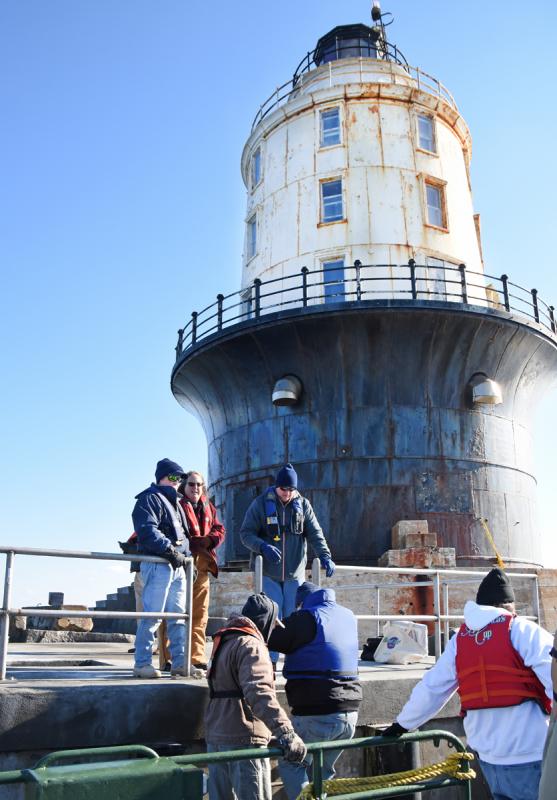There are few things more iconic in Lewes than its two lighthouses. If all goes to plan next year, the public may be able to tour one of them, the Harbor of Refuge Light.
The 76-foot-tall black-and-white beacon stands in the Delaware Bay at the Atlantic Ocean end of the outer breakwater. The lighthouse has been unreachable for the last six years, as the powerful winds and turbulent waters of the bay destroyed its dock 13 times in a seven-year span, said Red Moulinier, president of the Delaware River and Bay Lighthouse Foundation, which has cared for the lighthouse since 2002.
A pricey project to build a robust, concrete-and-steel dock was completed in November. Foundation board members and media visited the lighthouse Dec. 10 to see the results.
“It just blows my mind what we got for the money,” Moulinier said.
With a safe dock now in place, Moulinier said, maintenance work can begin. If all goes well, he said, public tours of the lighthouse could begin in 2017.
Funding for the dock came through a Hurricane Sandy relief grant from the Department of the Interior, which awarded Delaware $1 million for the repair of historic properties. The foundation was able to obtain nearly $750,000 for the dock project.
“Always shoot for the moon, because you never know what you’re going to get,” said Moulinier, who submitted the grant application on behalf of the foundation. “It worked out well for us, and we have a first-class dock out there now.”
Keast & Hood, a Washington, D.C.-based structural engineer, designed the dock, which is expected to last at least 20 years. It was constructed by Marine Technologies Inc., a Baltimore-based firm that specializes in marine and underwater construction.
“It was a challenge all the way through,” said Project Manager Luke Browning of Marine Technologies. “On the surface it doesn’t look bad, but when you go down a little bit, it is turbulent. It’s rockin’ out here.”
Moulinier described the construction as a large-scale erector set project, as the structural steel and front and side panels were all prefabricated and pieced together on site.
The new dock is cantilevered into the stone breakwater. The water at the lighthouse is as deep as 220 feet, and the breakwater is built like a pyramid, about 150 feet wide at the bottom and only about 30 feet wide above the surface.
Grated vents on the surface of the dock are designed to relieve pressure caused by the powerful bay.
The existing Harbor of Refuge Light went into service in November 1926, just six months after the infamous collapse of the Cape Henlopen Lighthouse, which stood in current-day Cape Henlopen State Park.
The Harbor of Refuge Light was manned until it was automated in 1973. At the time, all the windows were covered, and no one visited the lighthouse until the foundation entered into a 20-year lease with the U.S. Coast Guard in 2002. The foundation took ownership of the light in 2004 as a result of the National Historic Lighthouse Preservation Act of 2000.
“When we came in, we took all the [window coverings] off, light came in and what we saw was paint peeling everywhere,” Moulinier said. “It was a mess.”
That first day they also found an old 100-watt lamp sitting in pieces on the floor. It was later pieced back together and is displayed inside the lighthouse.
The foundation is waiting for the results of an interior and exterior assessment from Keast & Hood before moving ahead with lighthouse tours.
There are known issues with the cement ceiling inside the caisson or lower level of the light, Moulinier said. Any other issues Keast & Hood may identify in its assessment must also be addressed before the public is allowed to visit the lighthouse.
Mother Nature has taken its toll on the outside of the structure. A once-vibrant white beacon, it is now covered on all sides with rusty patches. Fresh paint is already on the list of jobs the foundation plans to undertake soon.
The interior of the lighthouse is in pretty good good shape considering it’s been vacant for six consecutive years, Moulinier said. The foundation has restored the structure’s third and fourth levels, and little work will need to be done moving forward. It is on the second level - the first above the caisson - that the foundation will focus its attention. With paint peeling from the walls and ceiling, the second floor had not been restored before the foundation ended its regular maintenance trips.
The foundation is seeking volunteers, specifically younger people who are eager to help with maintenance projects at the lighthouse. The group also seeks donations, as each trip out to the lighthouse is costly. For more information about the foundation, go to www.delawarebaylights.org or search for Delaware River and Bay Lighthouse Foundation on Facebook.

































































